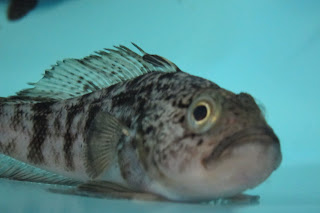Trematomus bernacchii
T. bernacchii are one of the most commonly caught species of fish in McMurdo Sound. They are primarily benthic, and, like most fish in the Antarctic, live at temperatures of -1.86C. We usually catch them at 70-100 feet deep (with hook and line), however they have been found in depths of >700m. The sizes of the bernies we have been catching are 40g-300g (>200g are usually gravid) with lengths of 15-25cm.
These fish are often dark or pinkish in color, with dark blotches or wide stripes. There are three morphs of T. bernacchii: some exhibit a white patch on their collar/back of head area, some have three white stripes, and some have no distinguishable markings.
We have also been catching a number of gravid bernies. Spawning takes place around December-January, at a time when we do not have access to the sea ice in McMurdo. Pictured left are a number of gravid females, taken December 2010.
Trematomus pennellii
Trematomus newnesi


 We have been catching T. newnesi more often these last couple years than in Brad's previous field seasons. We are not sure why they are showing up more now than they have before, especially since we are visiting the same fishing sites. Newnesi occupy various levels of the water column; we've been catching them on the bottom (at ~70-100 feet) and in the mid-range. The sizes of the newnesi we've caught so far range from 10-20cm, 20-100g. There are a couple morphs of T. newnesi, one with a large mouth and a broad, blunt head, and the "typical" morph, with a more pointy snout (Eastman and Devries, 1996). These fish differ from other Trematomids in that they lack a large, triangular shaped head like T. bernacchii, pennellii, hansoni, nicolai, etc.
We have been catching T. newnesi more often these last couple years than in Brad's previous field seasons. We are not sure why they are showing up more now than they have before, especially since we are visiting the same fishing sites. Newnesi occupy various levels of the water column; we've been catching them on the bottom (at ~70-100 feet) and in the mid-range. The sizes of the newnesi we've caught so far range from 10-20cm, 20-100g. There are a couple morphs of T. newnesi, one with a large mouth and a broad, blunt head, and the "typical" morph, with a more pointy snout (Eastman and Devries, 1996). These fish differ from other Trematomids in that they lack a large, triangular shaped head like T. bernacchii, pennellii, hansoni, nicolai, etc. Trematomus nicolai
T. nicolai look very similar to their Treamtomid relatives. They are often grey with spots on its classic triangular head shape. Their eyes are positioned on top of their head more, so that they seem to look up and not just straight out to the sides. The nicolai we have caught so far weigh in at 50-120g, and are 15-20cm long. We have been finding them at 70-100 feet in McMurdo Sound.
Pagothenia borchgrevinki
P. borchgrevinki (borks) is a cryopelagic fish, in that they normally live in the thin layer of brash ice that interfaces between the thick (1.5-2m) sea ice and water. We have occasionally found them on the bottom as well. They are long and silver with broad dark stripes, although often their entire body turns completely dark grey as a stress response. Most borks that we have caught this season are about 12 miles from town, and measure 55-135g and 15-25cm.Weddell seals have been known to blow air bubbles into the brash ice to push out and feed on borks. Although borks are in a different genus than the other fish we study, we are equally as interested in their reponse to changes in temperature.
Gymnodraco acuticeps
see also: The Underwater Field Guide to Ross Island and McMurdo Sound, Antarctica

















No comments:
Post a Comment